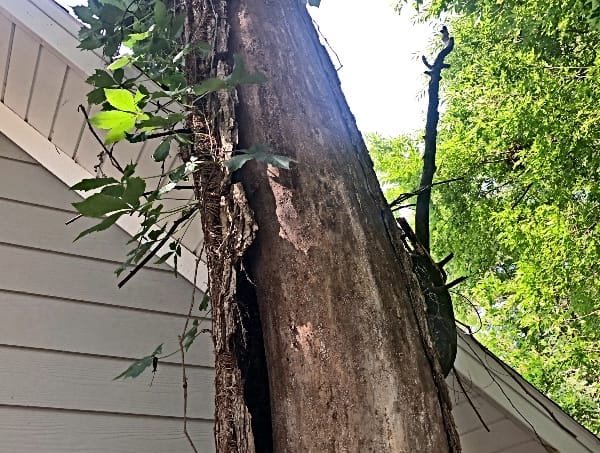

Uh oh...
It appears that you're using a severely outdated version of Safari on Windows. Many features won't work correctly, and functionality can't be guaranteed. Please try viewing this website in Edge, Mozilla, Chrome, or another modern browser. Sorry for any inconvenience this may have caused!
Read More about this safari issue.

If you are looking for a natural way to control mosquitoes and other annoying insects around your property, consider the bat. Arkansas is home to 16 bat species. According to the University of Arkansas Agriculture Department, studies of brown bats (Myotis lucifugus) indicate a single bat consumes 500 – 1,200 mosquitoes per hour! Imagine what a difference a few bats could make when it comes to enjoying your outdoor space at dusk.
To attract bats to your property, it’s helpful to understand the nature of the world’s only flying mammal. Before we discuss ways to create a bat-friendly habitat, read this article on Bats in Arkansas for an overview of the feeding and roosting habits of bats.
How to Create a Bat-Friendly Habitat
Go Native. Planting native vegetation—trees, shrubs, and flowers—will help attract a variety of insects. Since bats only eat insects, that’s a good thing.
But wait. If bats will feast on mosquitoes (and mosquitoes are plentiful), why bother providing other insects? Because just like humans, bats appreciate diversity in their diet. A native garden with a variety of insects will make your property more appealing than, say, your neighbor who grows turf and non-native flowers.

Water Source. Bats prefer to live within a quarter of a mile from a water source. Here in Arkansas, we have plentiful lakes and ponds, which makes for an overall desirable bat habitat. If your immediate area is without a natural source, adding a water feature can help.
Avoid Pesticides. Bottom line, the goal is to create a well-balanced, healthy, pollinator-friendly environment. Pesticides kill the food bats eat.
Snag Trees. Do you have a dead tree on your property? If it isn’t a hazard, leave it. You may have a natural bat house. Bats will often roost in the rough, tight gaps between the bark and wood.

Don’t bother with Bat Attractants. You might be tempted to buy bat attractants in the form of sprays or guano to help lure bats to your garden paradise. Experts say this is a waste of money. (Bat guano is, however, a nutrient-rich garden fertilizer.)
Grow a Moon Garden. Consider adding a few night bloomers to your garden mix. Flowers that bloom after sunset attract night-flying insects such as moths. Bats are the most significant predator of night-flying insects. Lovely night-blooming choices include phlox, fleabane, goldenrod, evening primrose, and moonflowers.

Install a Bat House. Bat houses can be purchased commercially or built at home. Whether you go the do-it-yourself route or buy a pre-fabricated house, construction and installation of your bat house will likely determine your success in attracting bats.
Tips on Bat House Design and Installation
Size and Style Matters. Tiny houses may be all the rage for people these days, but they aren’t the preferred home of bats.
- The ideal bat house size is 20 inches tall by 14 inches wide.
- The bat house interior should be tightly divided into slotted chambers (ideally two to six). Each chamber should be ¾ inch to 1 inch wide. The idea is to mimic the tight spaces in aged tree bark.
- So that the bat can cling and roost, the inside walls should have rough grooves.
- The house should be equipped with an enclosed roof and a landing pad.

Many garden centers and home improvement stores sell bat houses with only one chamber. These boxes may be considered “starter” bat houses, an easy way to get your feet wet in the area of hosting bats on your property. Fair Warning: bats prefer more cozy interiors, so you’ll likely have better success with multi-chambered houses.
DIY House. For the do-it-yourselfer, use untreated plywood or cedar because bats are sensitive to chemicals. (You can paint or stain the outside.) Make sure seams are sealed, and screws are flush. A variety of building plans can be found online, including via The University of Arkansas Cooperative Extension Service website.

BCI-certified. If you decide to purchase a bat house, consider buying one that is certified by Bat Conservation International.
Location, Location, Location.
- Bats like to be warm and comfy inside. Your bat house needs a minimum of 6-8 hours of sunlight during the day to warm the interior.
- Your bat house should be installed 12-20 feet above the ground.
- Don’t mount your bat house on the trunk of a tree. Not only will this be unsafe due to predators, but the spot will likely be shady and cooler.
- Don’t install near electrical lighting or porches. Bats like the dark.
Business owners and city planners—why not install bat-friendly habitats around commercial properties and in public places such as schools, parks, and office buildings?
This bat house at David W. McKee Architect in Fayetteville doubles as an outdoor sculpture. It’s visible from the Razorback Greenway.

Batty Problems?
Bat positives greatly outweigh the unlikely negatives. But if you are concerned bats could bring health problems, these facts from Bat World Sanctuary will put you at ease:
- Bats are not asymptomatic carriers of rabies. Less than ½ to 1% of bats carry rabies. Other animals are much more likely to carry the disease.
- You are more likely to catch leprosy or the plague than rabies from a bat.
- Bats rarely transmit rabies to other wildlife, dogs or cats.
- You can’t “catch” rabies from merely being around bats. Rabies is spread via a bite.
If a colony of bats takes up residence in the attic of your house (and you find them to be a nuisance), do not attempt to remove them. Contact the Arkansas Game and Fish Commission for wildlife nuisance assistance.

Arkansas—The Bat State?
Are you planning to install a bat house this summer? Do you have bat success stories to share? We’d love to hear from you!
Wouldn’t it be great if Arkansas became known for its numerous bat-friendly habitats?
We do the work.
You check your email.
Sign up for our weekly e-news.
Get stories sent straight to your inbox!












 Leave a Reply
Leave a Reply
The author, Talya Tate Boerner, and her artistic husband have created a bat-friendly habitat in Fayetteville known as “the cottage”. Her mother, theBAT lives there. That’s me.
We have at least one bat who flies around our yard at dusk, and have two houses we need to install. Thanks for this great info!!
Once you have a bat arond your house, it means that your surrounding has a healthy environment. We should know how to co-exist with other life forms such as bats
Bats in the belfry (attic) are a messy nuisance. If you can, place the bat houses at least 100′ from your house.
And don’t mind when they play in your hair.
Very interesting article! I plan to put up a bat house later this year.
Really interesting and lots of info. Our condo complex near Table Rock Lake (Eureka Springs/Holiday Island in NWA) have bats in eaves and spaces that produces disturbing noises (mice? rats? squirrels? turns out bats – maybe?) and piles of droppings on decks and in front of entry door — sooooo, people want them elsewhere — as in a bat house habitat. Are there experts who can guide us on bat relocation process? Someone who can walk us through the process? Thanks in advance.
Wasps and hornets are a problem around my house. Will they take over a bat house? Do they injure bats? I don’t want to entice bats to their doom.
With the gray nose disease and CORONA any virus – is this still now considered a safe practice? I have a bat house I want to put up but am concerned now.